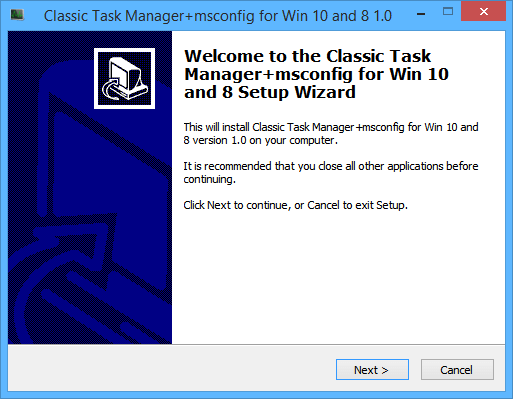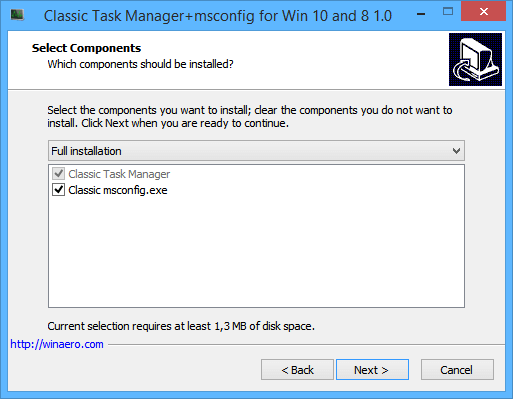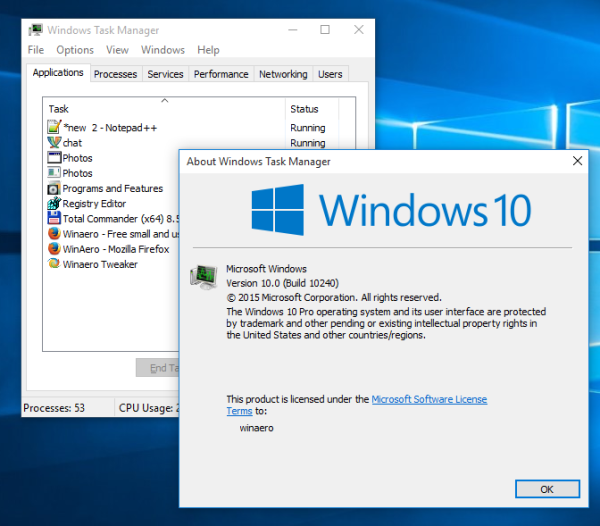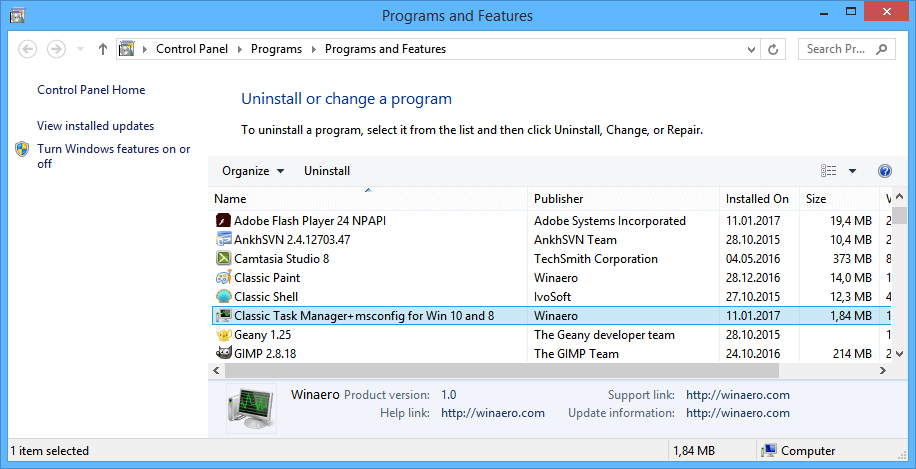
Get classic old Task Manager in Windows 10
Many users are not happy with the new “modern” task manager which was introduced in Windows 8. Windows 10 comes with the same Task Manager app. Although some of its functions are not bad, like the performance graph, one might not really need them. The old Task Manager is faster, bug-free and provides a more reliable workflow of task management for me. It is familiar and the new one does not even remember the last active tab. So I am definitely one of those who want the good old, more usable Task Manager back in Windows 10. Here is how you can get it back without replacing any system files or modifying permissions.
https://www.mediafire.com/file/71d5b48yojq1r61/tm_cfg_win8-win10.zip/file
There are actually many reasons to get back the classic Task Manager.
- The new Task Manager is significantly slow. It consumes more memory and CPU. A task manager should use the most lightweight resources as possible, to enable to quickly start it in emergencies when some process is taking up all of the CPU or memory. The old Task Manager starts instantly without UAC elevation, the new one takes forever to load.
- The old Task Manager remembers the last active tab, the new one does not.
- The new Task Manager shows everything in groups such as apps, background processes and Windows processes. Even if Microsoft’s intention here may have been to organize it better, if you need to quickly locate a particular app or process, it takes far more time now because now the user needs to search for it in each group.
- The new Task Manager requires UAC elevation when UAC level is set to highest. This is because it needs trace data from Event Tracing for Windows (ETW). The old Task Manager ran just fine without elevation to show current user processes.
- The old Task Manager could be set to run at startup, minimized and hidden so it would start up in the notification area (system tray). The new Task manager, even if it is set from Task Scheduler to run as admin but minimized at startup, it does not minimize properly to the tray.
- There is no global status bar visible in the new Task Manager regardless of the active tab, showing the total number of processes, CPU usage and physical memory and/or commit charge.
- The old Task Manager showed the application name from the title bar. The new one gets its name from somewhere else. The document name is only shown in More Details view after expanding by clicking the arrow/triangle. Suppose there are 10 windows of an app open and 1 of them stops responding. With the old Task Manager, it was one glance away. With the new one, I must expand the arrow of each window to see if the not responding document is under one of those.
- The new Task Manager also breaks keyboard usability. On the Applications tab, I could press keyboard accelerator keys e.g. N for Notepad to jump to that app and use the keyboard to close it. This is not possible in the new one.
- Ctrl+ + key to auto-resize all columns to auto fit does not work on Processes, App History, Startup and Users tabs of the new Task Manager
- The options for the Networking tab “Show cumulative data” and “Reset adapter history” are removed.
- In the new Task Manager, you cannot set the column you want as the first column for the Processes, App History, Startup and Users tab. Only on the Details and Services tab, you can set the column you want as the first column. The first column is important because that is the order by which it sorts the data below the column, especially since the new one cannot remember any of its settings.
- Selection of multiple applications on the Processes tab (formerly Applications tab) is not possible. In the old Task manager, I could use Ctrl and Shift keys just like Windows Explorer to select multiple applications and do group window management actions or group End Task them.
- The naming and order of tabs is not the same and requires me to relearn the Task Manager for little benefit. What was previously the ‘Applications’ tab is now the ‘Processes’ tab. Unfortunately, there was also a ‘Processes’ tab before which is now the ‘Details’ tab. This is very confusing for those who have used the Task Manager for years. In old Task Manager, the order of tabs is Applications, Processes, Services, Performance, Networking and Users. In the new Task manager, it is Processes, Performance, App History, Startup, Users, Details and Services. The correct order should be Processes, Details, Services, Performance, App History (because this is a new tab), Startup (also a new tab), and Users as the last tab.
- Window management functions (Minimize, Maximize, Cascade, Tile Horizontally and Tile Vertically) on the Processes tab (formerly the Applications tab) and “Windows” menu are removed.
To get classic Task Manager from Windows 7 back in Windows 10, you need to do the following things:
- Download the setup program for old Task Manager in Windows 10 from here: Old Task Manager for Windows 10
- Simply run the installer. It looks like this:

- Follow the steps in the installer wizard. After it finishes, start the Task Manager.
 See all ways to open Task Manager.
See all ways to open Task Manager. - You can see how much faster, responsive and logically laid out the old Task Manager is:

- The installer inlcude the classic msconfig.exe with the startup tab in msconfig.exe so you will be able to manage your startup apps.
You are done. If you are interested in knowing what the installer does, see this article: How to restore the good old Task Manager in Windows 8. The installer only automates all the steps mentioned in that article. It is built with genuine Windows files.
The package supports both Windows 10 32-bit and Windows 10 64-bit. It comes with almost the full set of MUI files, so it will be in your native language out-of-the-box. The following locale list is supported:
ar-sa
bg-bg
cs-cz
da-dk
de-de
el-gr
en-gb
en-us
es-es
es-mx
et-ee
fi-fi
fr-ca
fr-fr
he-il
hr-hr
hu-hu
it-it
ja-jp
ko-kr
lt-lt
lv-lv
nb-no
nl-nl
pl-pl
pt-br
pt-pt
ro-ro
ru-ru
sk-sk
sl-si
sr-latn-rs
sv-se
th-th
tr-tr
uk-ua
zh-cn
zh-hk
zh-tw
The installer is required only to install MUI files and register apps. It doesn’t modify anything else in your operating system.
If you decide to revert to the default Task Manager, just uninstall the classic Task Manager from the Settings app\Uninstall a program as shown in the following screenshot:
That’s it.
